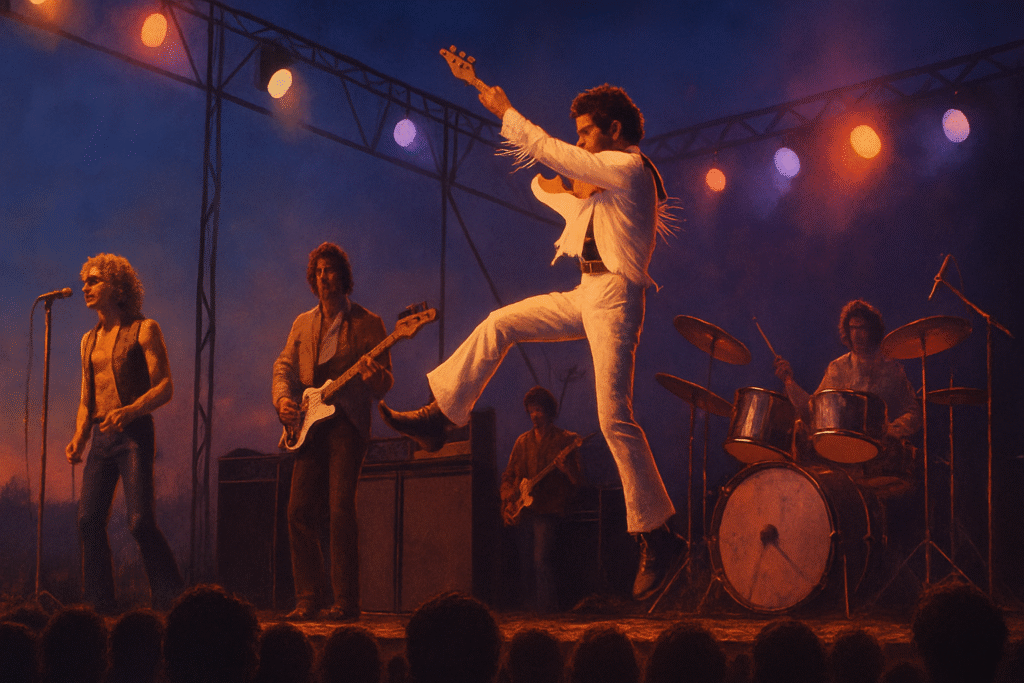
AI-generated image for illustrative purposes.
The Who: Rock Opera at Daybreak
When The Who finally stormed the Woodstock stage, it was past 5 a.m. on Sunday. By then, delays were part of the festival’s DNA. Half the crowd was passed out in the mud, while the diehards clung on, desperate to see the British powerhouse. Pete Townshend, Roger Daltrey, John Entwistle, and Keith Moon arrived angry at the chaos behind the scenes — but once the opening chords rang out, the atmosphere flipped.
In 1969, The Who were riding high on the release of Tommy, the first rock opera to break through. Woodstock became one of the earliest shows where they performed much of the album live, and songs like Pinball Wizard and Sparks hit with brutal force at dawn, with the crowd still dazed and worn out.
Despite the cursed hour, the performance was explosive. Townshend unleashed his signature windmills, slashing the air with his guitar like a weapon. Moon, wild and unstoppable, pounded as if there were no tomorrow. And Daltrey, voice ragged from the road, still roared with power on See Me, Feel Me.
The Defining Moment
As the sun rose behind the stage and The Who launched into See Me, Feel Me, the exhausted crowd surged to its feet in euphoria. That fusion of music, fatigue, and morning light became one of Woodstock’s most enduring images.
Jefferson Airplane: Psychedelia at Sunrise
Right after The Who came Jefferson Airplane, stepping onstage in full daylight Sunday morning. The San Francisco band were icons of the West Coast psychedelic scene, already cult heroes after Surrealistic Pillow (1967).
Grace Slick greeted the crowd with a wry grin: “Good morning, people! You’ve stayed up all night with us.” Then came Somebody to Love and White Rabbit, two anthems that had become shorthand for the psychedelic ’60s.
The set wasn’t flawless. The sound was distorted, the gear beaten down by rain and overuse, and the musicians visibly weary. Yet Grace’s charisma and the band’s intensity turned the sunrise into a shared trip.
The Defining Moment
White Rabbit, sung under the rising sun, became a trippy Alice-in-Wonderland fever dream. The crowd — worn out, stoned, and entranced — gave in to the psychedelic chants that rolled across the field.
Between Chaos and Catharsis
Woodstock’s long night made clear the festival was never about perfection. The Who and Jefferson Airplane battled delays, bad sound, and a half-dead audience. But instead of crumbling, they turned it into fuel.
The Who brought British fury and gifted Woodstock one of rock’s most iconic dawns. Jefferson Airplane delivered the pure spirit of psychedelia, messy and transcendent. Between slashing guitars and an acid-drenched atmosphere, the night bled into eternity.
Burning Questions
Were The Who at their peak during Woodstock?
Yes. Tommy had just been released, cementing them as innovators merging rock with grand concepts.
Did Pete Townshend really attack Abbie Hoffman onstage?
Yes. Hoffman stormed the stage to protest John Sinclair’s jailing, and Townshend, furious, shouted him down and shoved him off with his guitar.
Why is Jefferson Airplane’s set remembered despite the flaws?
Because White Rabbit and Somebody to Love distilled the psychedelic era. Context mattered more than precision.
Did the sunrise add to the mystique?
Absolutely. The mix of exhaustion, music, and dawn gave those performances an almost mystical aura.
— Lena Blaze, Rock Vaults
